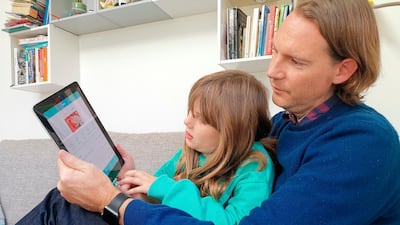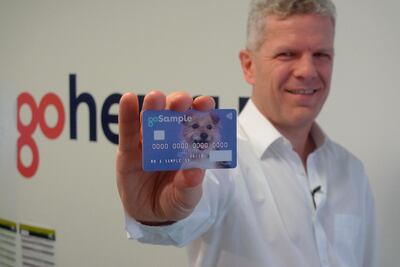For children growing up in today's cashless society, the pocket money is now going virtual.
Father of two Roland Hall turned to a British startup's digital pocket money app because his kids were still too young to get bank cards from traditional banks.
With prepaid debit cards linked to the app, Mr Hall's offspring, aged 8 and 10, can spend their allowance and chore money by shopping online or by tapping at contactless payment terminals in stores. Sound like a recipe for splurging? Not so, he says.
"When kids have cash they want to spend it quickly. They want to go to the shops and spend it on rubbish," says Mr Hall, an IT project manager. But an app lets them check their balances online, "which actually makes them start thinking about saving rather than getting rid of the money," he adds.
Mr Hall also prefers giving digital allowances because he never carries cash.
The app, which is called gohenry and expanded to the US in April, is part of a wave of digital money apps combined with prepaid cards for kids as young as six that parents have access to. They are powerful new money management and savings tools that replace old-fashioned money boxes and account passbooks. Some say they can help enhance financial literacy even as the growth of cashless payments upends traditional notions of money.
___________
Read more:
Generation start-up: The UAE discount voucher firm scoring big with Samsung Pay
Going cashless: accepting coins and notes no longer worth it for US restaurants
Changing times: contactless payments now the norm in London
How a cashless society is boosting the fortunes of London's homeless
All you need to know about digital wallets in the UAE
___________
Globally, the number of non-cash transactions rose 11.2 per cent to $433 billion in 2015 from the year before and is forecast to nearly double by 2020, according to the World Payments Report by financial services firms Capgemini and BNP Paribas.
Britain, Canada and Sweden are among the world's most cashless countries, according to a 2017 ranking by currency website ForexBonuses, with widespread use of "contactless" bank cards that let shoppers merely tap on payment terminals for small transactions.
In China, where mobile payments rule, Alipay and WeChat Pay allow teens to hold accounts. Hong Kong offers a kids' version of its stored value Octopus card, based on older technology.
In the US, the fragmented banking sector means most cards still need to be swiped and, sometimes, require a pin number. Merchants in big US cities are increasingly going cashless because they can gather more customer data, which makes it harder for teens without bank cards, says Stuart Sopp, chief executive of Current, a two-year-old US fintech startup.
"Parents are willing to pay to solve a problem that banks are not solving" - helping youngsters deal with digital money, says Mr Sopp.
Current, gohenry and others such as Britain's Nimbl and Osper, Australia's Spriggy and Famzoo and Greenlight of the US operate on similar principles. They typically charge a monthly or annual fee for prepaid debit cards. Parents can load money from their bank onto their own account, set weekly allowance amounts and spending limits, list chores to earn extra money, and block certain types of transactions, like online shopping.
Money is sent to kids' linked accounts, which they can use to set savings goals. The Current app rounds up each transaction and sweeps the change into a savings account.
Crucially, the apps send instant alerts about transactions, a feature parents love, says gohenry chief executive Alex Zivoder.
"You give cash to a kid, how do you as a parent know what he will do with this money?" he says.
Mr Hall says his son, Ralph, 8, uses it to save up to buy £70 pound (Dh329) football shoes and PlayStation video games while his daughter Lilly, 10, saves for shoes or clothing. They both also save up to buy extras on the video game Fortnite.
He says he turned to the app because "I want them to understand what the value of money is".
The apps are making inroads amid growing adult uncertainty about how the shift to cashless payments is affecting children's view of money. In one UK survey commissioned last year by Prudential, about 78 per cent of teachers and 37 per cent of parents said it hurt youngsters' understanding of money.
More than a quarter felt contactless cards encouraged them to spend more and did not help them develop mental arithmetic skills as well as handling cash, the poll of 501 parents found. No margin of error was given.
They are valid concerns, says Russell Winnard, head of programmes and services at UK financial education charity Young Money, but he adds that apps can help parents explain to children how money works.
"Young people are seeing less and less cash transactions, which just means that we have to be even more careful to talk about what is happening at each of those stages, because it has become more abstract," says Mr Winnard.
Paddy Kelly, another gohenry user, says he started using it because he was looking for a better way to help his 8-year-old daughter, Ailish, both save money and improve her math skills.
She had a money box full of coins but her younger brother kept emptying it, Mr Kelly says.
He likes the app's savings feature, which his daughter has used to set a goal of saving £20, at £2 per week, with the aim of buying a pet gerbil. Getting her to figure out how long it would take to reach that goal is better than forcing her to do abstract math questions, which just makes her "irate," he says.
"It gets her thinking about money in a slightly smarter way," says Mr Kelly. "Money is such an abstract concept, in today's world it kind of makes sense" for kids to use digital pocket money apps, he adds.


